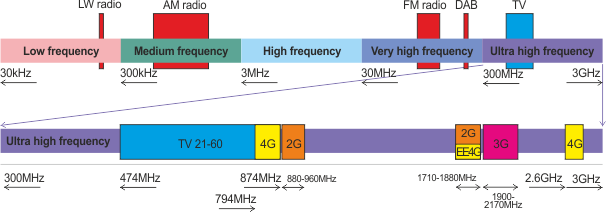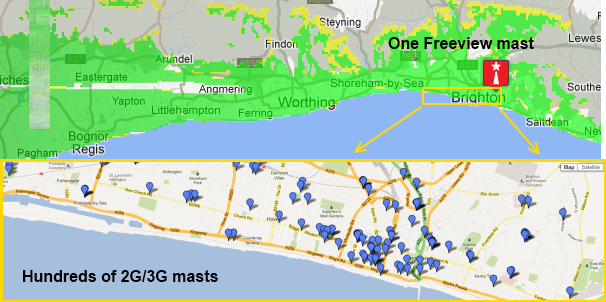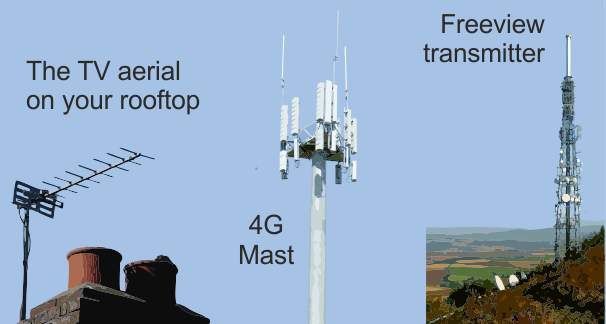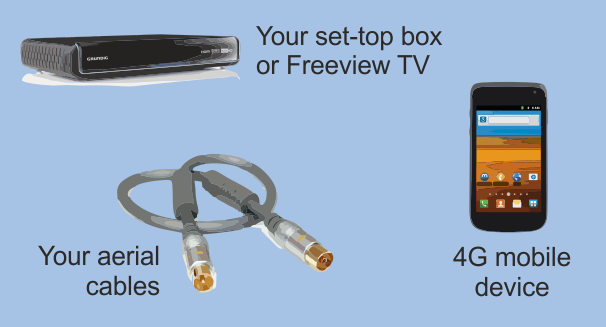How do I know if the 4G broadband will overload my Freeview?
 Brian Butterworth published on UK Free TV
Brian Butterworth published on UK Free TV Back in June 2011, we looked at how Ofcom moves to protect Freeview interference from 4G mobile .
Since then, the television Digital Switchover has been finished and 4th generation (4G) mobile broadband services - also known as Long Term Evoluition (LTE) have launched all over the world, including a service from Everything Everywhere (EE) in the UK.
To understand why and how these 4G broadband services will cause problems during 2013, you need to take into consideration a number of technical factors.
Understanding the radio spectrum
The Radio spectrum is the name given to the frequencies of the electromagnetic spectrum that can be usefully used to transmit radio, television and data services.The top bar on the diagram below (or download) shows a selection of the services used in the UK, with old-fashioned long-wave radio, then medium-wave radio, though FM radio, the digital DAB radio services up to those used for television broadcasting. (See here for a really complex chart).

The highest frequencies on the diagram, the "ultra high frequencies" (or UHF) band is shown enlarged as the lower purple bar. In this range we can see TV "channels C21 to C60" (blue), second- and third- generation mobile phones (2G orange, 3G pink) and the location for the 4G services.
It is important to note that some of the 2G capacity in the "1800MHz" range has already been converted to 4G operation by Everything Everywhere (EE). The other two yellow boxes show the "800MHz" (to the left) "2.6GHz" (on the right).
For the purpose of Freeview reception, only the 800MHz range need be considered. The other two ranges will not cause Freeview problems.
Protecting Freeview receivers against overload
As we have seen already - Freeview signals: too much of a good thing is bad for you - Freeview boxes are designed to protect themselves against signal overloads. When they do this they close down and people often incorrectly diagnose the problem as being "no signal" when there is too much.The problem that has to be solved as the 4G services launch, is that the new mobile broadband signals can cause overloads onto the frequencies that are being used for Freeview.
 One particular problem is that a very common type of Freeview signal decoder, a superheterodyne receivers are sensitive to signals being present nine channels (72MHz) away.
One particular problem is that a very common type of Freeview signal decoder, a superheterodyne receivers are sensitive to signals being present nine channels (72MHz) away.
In addition to overloads, 4G may also cause Signal-Interference Noise Ratio degradation, where reception breaks down because the receiver can no longer decode the digital information in the transmission.
Knowing who will win the 4G auction
 Until the
4G auction takes place, no one will know which company has the right to use the 800MHz channels for mobile devices. The following companies have qualified to bid:
Until the
4G auction takes place, no one will know which company has the right to use the 800MHz channels for mobile devices. The following companies have qualified to bid:
- Everything Everywhere Limited (UK)
- HKT (UK) Company Limited (a subsidiary of PCCW Limited)
- Hutchison 3G UK Limited
- MLL Telecom Ltd
- Niche Spectrum Ventures Limited (a subsidiary of BT Group plc)
- Telefonica UK Limited
- Vodafone Limited
Viewing high power television and using low power mobiles
Using the 'Sitefinder' Mobile Phone Base Station Database you can compare the locations of existing mobile phone "masts" with those used for Freeview Transmitters. Here is an example from Brighton and Hove, where a medium-sized single mast (Whitehawk Hill) can cover a whole city, but where hundreds of mobile phone base-stations cover a many smaller-by-comparison areas.
This illustrates two points. Firstly, that Freeview broadcasts are high powered and one-to-many - mobile devices are low power and peer-to-peer. The mast your TV signal comes from may be miles, sometimes tens or miles away, for your mobile perhaps only meters away.
The second point is that if an existing 2G/3G mobile supplier wins a 800MHz 4G slot, they will wish to use their existing "phone mast" locations (especially the 900MHz ones) as this would be most economical for them. Until the action winners emerge, and then plan their network, only idle speculation about possible interference can be made.
Using the TV frequencies for 4G masts and phones
Research (see here) shows that a 4G mast in relative close proximity, or a mobile 4G handset closer than a meter to an unfiltered Freeview box will cause overloading on many tested devices. The following diagram shows the relationship between the 4G use and the old TV channel designations.
Those Freeview transmitters that use channels above C52 are most likely to have receivers that get overloaded by the use of 4G signals in the 800MHz area. FDD is Frequency-division duplexing - the transmitter and receiver operate at different carrier frequencies.
Interpreting the aerial and mast locations
Once the proposed mast locations for 4G services are known, it will then be possible to predict which homes will need to fit the special filters in areas where Freeview uses the higher channel numbers (the C52 to C60 range).
If you then have a rooftop aerial without a signal amplifier, to get an overload you will need the 4G mast to be in the line-of-sight between your Freeview transmitter and the aerial, or possibly "directly behind" the aerial.
If you then have a rooftop aerial and an amplifier, or perhaps have lower-grade cables, you are likely to need to protect from a 4G overload if the phone mast is close to your rooftop aerial.
Finding transmitters that use the higher range frequencies
Some powerful transmitters and many relays use the high frequencies: Sudbury, Oxford, Belmont, Winter Hill, Tacolneston, Pontop Pike, Mendip, Emley Moor, Clermont Carn, Truskmore and Maghera.Click below to find out the transmitters in with high frequency allocations:
- C60 is used by 126 transmitters - including Sudbury, Oxford, Belmont;
- C59 is used by 142 transmitters - including Winter Hill and Tacolneston;
- C58 is used by 100 transmitters - including Winter Hill, Sudbury, Pontop Pike and Mendip;
- C57 is used by 131 transmitters - including Clermont Carn, Truskmore, Oxford;
- C56 is used by 73 transmitters - including Mendip, Sudbury;
- C55 is used by 139 transmitters - including Maghera, Winter Hill and Tacolneston ;
- C54 is used by 104 transmitters - including Mendip, Pontop Pike and Winter Hill;
- C53 is used by 131 transmitters- including Truskmore, Belmont, Oxford;
- C52 is used by 81 transmitters - including Emley Moor, Sandy Heath, Clermont Carn and Mendip.
Protecting Freeview boxes and sets, cables, amplifiers from 4G devices
Again in areas where Freeview uses the higher channel numbers (C52 and above) you may have to protect your Freeview devices from signals from a 4G handset (such as mobile phone, tablet, or USB "dongle").
This may, once again, require the fitting of a special filter, or the upgrading of the "fly leads" used to connect your aerial to the set top box or TV. This may be a particular problem if you have used an indoor aerial or signal amplifier.
Help with TV/radio stations?
In this section
Wednesday, 17 April 2013
R
Robert McClymont6:57 PM
Bleeding into frequencies (Interference):
Interference is known as bleeding into frequencies that happens when none used frequency space is NOT being used to separate in this case between TV & 4G.
Bleeding into frequencies is not allowed so why has the government not used frequency spacing between TV & 4G, answer it loss money to have none used frequency, bandwidth. None used (spacing) amateur (ham) radio uses this spacing area however they do not bleed causing interference due to skills, closing this spacing
no frequencies for amateur radio. Government, corporate greed I can see ending up legal due to each other bleeding into each others purchased (property) frequencies.
| link to this comment |
Thursday, 18 April 2013
J
Jenny2:43 PM
Perth
I have lost all the bbc channels from my TV. How do I get them back or retune my TV? I am in Perth Scotland
| link to this comment |
Jenny's: mapJ's Freeview map terrainJ's terrain plot wavesJ's frequency data J's Freeview Detailed Coverage
Jenny: You need to retune because BBC services have changed frequency.
Knowledge of the make and model number may allow the user manual to be found in order give guidance on retuning.
In general, I would bring up the menu and look for something like "Setup" or "Installation".
| link to this comment |
Friday, 19 April 2013
J
Jan4:32 PM
Since the transmitter update in Selkirk on Wednesday, we have had no TV signal on our Technika TV (in Galashiels). We have re-tuned the television and also tried going back to the original setup, but still nothing. The television is only a month old and has built in Freeview but each time we re-tune it says there are no channels found. We had an excellent picture prior to the retune on Wednesday, but have not had any TV for three days now. Any suggestions as to how to get a signal back?
| link to this comment |
J
jb386:35 PM
Jan: Although an engineering notice was posted to the effect that from the 15th the Selkirk transmitter was liable to interruption, however any breaks that do take place are usually only in the order of 15 minutes or so and so your problem "might" possibly be coincidental.
The other point being, that a proper assessment of your situation with regards to the signal strength expected at your location cannot be made by anyone without knowledge of the post code involved, or at least one from somewhere nearby e.g: a shop or post office, as only then can the necessary info regarding the transmitter be accessed.
Have you made any local enquiries (neighbour etc) for the purpose of ascertaining if the problem is also being experienced by others?
| link to this comment |
T
thomas rance7:30 PM
Wallingford
itv channel 4 and 5 are pixelating bbc is ok as are sky news and some others we are post code ox109py
| link to this comment |
thomas's: mapT's Freeview map terrainT's terrain plot wavesT's frequency data T's Freeview Detailed Coverage
J
jb389:21 PM
thomas rance: As Oxfords ITV1 / Ch4 / Ch5 are all on multiplex Ch60 then you should carry out a signal strength / quality test on ITV1 just to ensure that your TV or box has not accidentally picked up Crystal Palaces ITV1 on mux Ch26 during an auto-tune, the mux channel involved usually always being given along with the level indications.
| link to this comment |
Friday, 26 April 2013
S
Simon Hargreaves3:06 PM
Bolton
Hi. Just a very quick question please. I am currently using a DVB-T TV USB dongle and laptop to view freeview channels and for the past week have not been able to get a strong signal for any of the BBC Channels or more specifically Talksport.
I am in the BL4 area (Kearsley) and my local transmitter is Winter Hill. Any ideas/ comment gratefully received!!
| link to this comment |
Simon's: mapS's Freeview map terrainS's terrain plot wavesS's frequency data S's Freeview Detailed Coverage
Saturday, 27 April 2013
S
Simon Hargreaves1:17 PM
Bolton
Please disregard the above as I have solved the above (aerial was pointing more towards the Haslingden Transmitter than Winter Hill!!)
| link to this comment |
Simon's: mapS's Freeview map terrainS's terrain plot wavesS's frequency data S's Freeview Detailed Coverage
Sunday, 28 April 2013
Hi
I get Freeview from Cystal Palace transmitter as I live in Deptford SE8 and my flat( High rise) has direct line of site. Apparently the 4G test signals being used from 15th April by at800 didnt occur. When I rang at800 they could only confirm that no test signals were made but couldnt tell me what date they would start. However since mid April my previously good Freeview signal (indoor aerial by window)gave excellent reception on Film4. Now it breaks up constantly as does ITV1 but ITV1HD is perfect.I gave my details to at800 as I hadnt' received the postcard from them informing me I live in area that may get problems from 4G from Crystal Palace but I have heard nothing from them.
Any suggestions/thoughts welcome.
| link to this comment |
Tony's: mapT's Freeview map terrainT's terrain plot wavesT's frequency data T's Freeview Detailed Coverage
Select more comments
Your comment please!